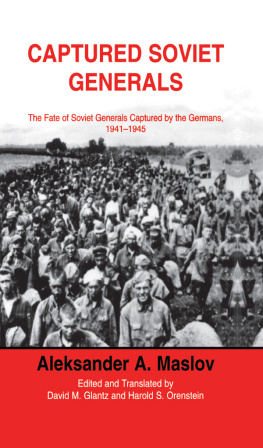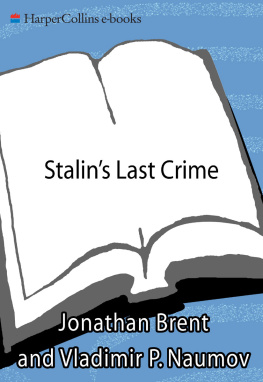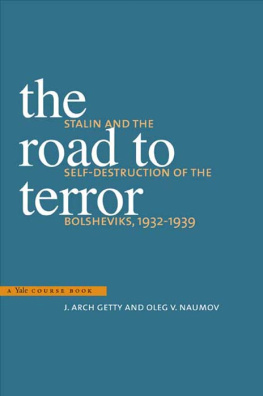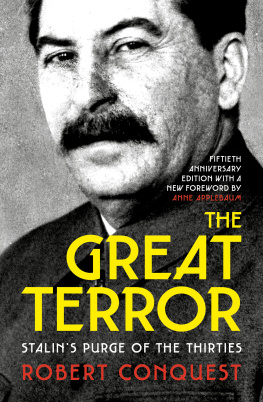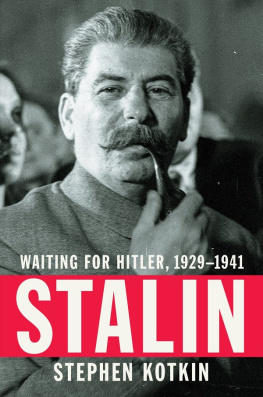The Red Army and
the Great Terror
MODERN WAR STUDIES
Theodore A. Wilson
General Editor
Raymond Callahan
Jacob W. Kipp
Allan R. Millett
Carol Reardon
Dennis Showalter
David R. Stone
Series Editors
The Red Army and
the Great Terror
Stalins Purge of
the Soviet Military
Peter Whitewood
2015 by the University Press of Kansas
All rights reserved
Published by the University Press of Kansas (Lawrence, Kansas 66045), which was organized by the Kansas Board of Regents and is operated and funded by Emporia State University, Fort Hays State University, Kansas State University, Pittsburg State University, the University of Kansas, and Wichita State University
Library of Congress Cataloging-in-Publication Data
Whitewood, Peter.
The Red Army and the Great Terror : Stalins purge of the Soviet military / Peter Whitewood.
pages cm. (Modern war studies)
Includes bibliographical references and index.
ISBN 978-0-7006-2117-0 (cloth : alk. paper)
ISBN 978-0-7006-2169-9 (ebook)
1. Political purgesSoviet UnionHistory. 2. Stalin, Joseph, 18781953.
3. Soviet Union. Sovetskaia Armiia. 4. Vsesoiuznaia kommunisticheskaia partiia (bolshevikov)Purges. 5. Soviet UnionPolitics and government19361953. 6. Political persecutionSoviet UnionHistory.
I. Title.
DK266.3.W48 2015
355.0094709043--dc23
2015016627
British Library Cataloguing-in-Publication Data is available.
Printed in the United States of America
10987654321
The paper used in this publication is recycled and contains 30 percent postconsumer waste. It is acid free and meets the minimum requirements of the American National Standard for Permanence of Paper for Printed Library Materials Z39.48-1992.
Contents
Acknowledgments
This book owes a considerable debt of gratitude to many people who have contributed to its creation. I owe special thanks to James Harris, who has been a constant source of encouragement and incisive criticism from the very early stages of this research. James kindly shared archival sources and read several draft versions of this manuscript. Others who have read the whole or parts of the book and given me the benefit of valuable suggestions include Roger Reese, David R. Stone, Stephen Brown, and Steven J. Main. I owe thanks to Mark B. Smith for conversations about this research and his encouragement to think about the social history of the Red Army. Mark Harrison provided insightful advice and forced me to challenge many of my assumptions. Any errors remaining in what follows are my own.
I am grateful for a travel grant from the Royal Historical Society and funding from the School of History at the University of Leeds that allowed me to travel to Moscow to carry out archival research. I owe thanks to the staff at the Russian State Military Archive and the Russian Archive of Socio-Political History for their assistance and patience. Researching in Moscow would have been impossible without Irina and Dmitri, who showed me nothing but warm hospitality during my stay.
The second half of was published as The Purge of the Red Army and the Soviet Mass Operations in Slavonic and East European Review. Elements of several chapters have been published in Europe-Asia Studies in Subversion in the Red Army and the Military Purge of 19371938.
Finally, I owe a debt of gratitude to my parents for their unwavering support throughout my PhD and beyond, without which writing this book would have been impossible. It is to them that I dedicate this book.
Introduction
On 11 June 1937, a closed military court sentenced a group of the Red Armys most talented and experienced officers to execution. Charged with membership of a supposed military-fascist plot, working with the Nazis, and planning to overthrow the Stalinist regime, all were shot immediately after the trial. The executions of Marshal Mikhail Tukhachevskii, Iona Iakir, Ieronim Uborevich, Boris Feldman, Robert Eideman, Avgust Kork, Vitalii Primakov, and Vitovt Putna sparked international scandal. Tukhachevskii in particular was world renowned. He was a hero of the Russian civil war and the Red Armys most capable strategist. Moreover, as soon as this supposed military conspiracy was discovered, Josef Stalin and the head of the Red Army, Kliment Voroshilov, ordered a massive purge of the armed forces. A wave of repression quickly spread throughout the officer corps and the rank and file as a growing number of fellow conspirators were connected to the military-fascist plot. This purge was not brought to a halt until November 1938, and it cost the army dearly. In addition to the execution of some of the Red Armys most talented officers, over the next two years, approximately 35,000 military leaders were discharged from the ranks. Thousands were arrested, and many were executed.
The military purge is a pivotal event in the history of the Great Terrorthe name given to the surge in political violence and repression in the mid- to late 1930s, during which over one million Soviet citizens were imprisoned in labor camps and over 750,000, at the very least, were executed. During these years of repression, the military purge marked the point at which the growing political violence, formerly almost exclusively targeted at Stalins old political opponents, began to affect those without such black marks on their records. Someone like Mikhail Tukhachevskii, for instance, had never supported the former political opposition before his arrest and execution. The military purge was thus not merely an attack on the Red Army. As we shall see, the military purge broadened the scope of the Great Terror in a number of important respects.
The reason why Stalin lashed out at his military in such an extreme manner in the summer of 1937 remains a mystery. What is certain is that there was no genuine conspiracy inside the Red Army. It has long been known that the military-fascist plot had no basis in reality. Evidence used in support of the conspiracy was obtained by the Soviet political police by forced confessions and torture. After Stalins death in 1953, many victims of the military purge (like other prominent victims of the wider Great Terror) were posthumously rehabilitated during Nikita Khrushchevs de-Stalinization. However, this explanation has immediate and obvious flaws. If consolidation of power was the main objective of the military purge, Stalin chose a terrible time to do this. As we shall see, from the Soviet leaderships point of view, world war was on the horizon in the mid-1930s, and Soviet defense spending was rising rapidly in response. Why would Stalin build with one hand and destroy with the other? Why actively prepare for war while weakening the Red Army through a mass purge? The military purge potentially put not only Stalins own grip on power in danger but also the existence of the entire Soviet Union, as Stalin might be forced to fight any future war with a weakened military. On the surface, the military purge appears to be an irrational act; it does not sit comfortably with an explanation focusing on Stalins desire for greater personal power and control.
In this book, I offer an entirely new explanation for the military purge. I show why Stalin thought that such a great risk needed to be taken in 1937 and why, at least from the perspective of the Soviet leadership, this was not irrational. Stalin launched a wave of repression against the Red Army not as another part of a carefully orchestrated consolidation of power. Rather, he did this from a position of weakness and at the last moment. By mid-1937, in what was recognized as a time of looming war, Stalin misperceived a security threat from within his army. He came to incorrectly believe that it had been infiltrated by foreign agents at all levels. Moreover, not only had these spies managed to get inside the Red Army, but so-called evidence obtained by the political police sketched out a conspiracy at the very heart of the high command. On the basis of these misperceived dangers, Stalin was compelled to crack down on the Red Army. He thus sanctioned a major purge to root out the subversives he believed were hidden in the ranks. From Stalins point of view, how could he fight the coming war with a military that had been so badly compromised? However, as an expanding wave of discharges and arrests ripped through the Red Army starting in June 1937, the military purge, like the wider Great Terror, escaped central control. This was partly reestablished in early 1938, and the military purge was eventually called to a halt in Novemberthe same time that the wider Great Terror was brought to a closebut not before it had caused massive damage to the Red Army. To explain why the military purge was launched, it is thus necessary to try to understand how the Soviet leadership could so badly misperceive the danger from the Red Amy in 1937 and come to believe that such drastic action was unavoidable. However, before doing so, a short survey of previous accounts of the military purge will show why few of these have been convincing.


